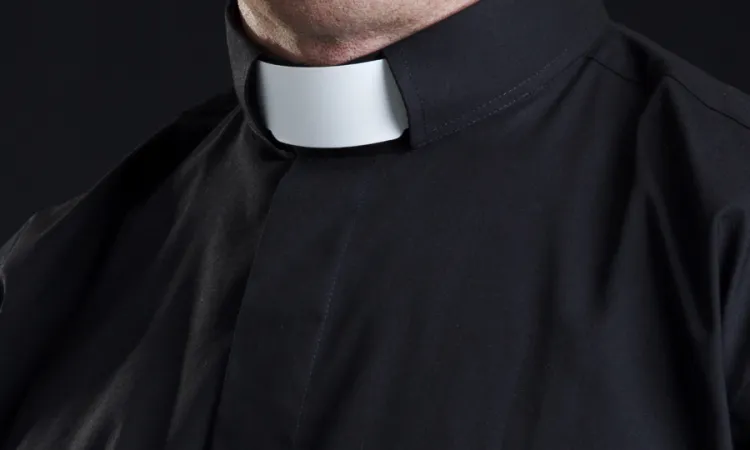The adjective "permanent", often used to describe married deacons, does not change the nature of the ordination or what is sacramentally conferred with the imposition of the bishop's hands on the man called to the office. A deacon is a deacon. Rather, it denotes the intention of the deacon to remain in that rank of ordered service as a member of the clergy. A transitional deacon intends to be considered for ordination to the priesthood.
Married Priests
Second, we have a growing body of married men who have been ordained to the Catholic priesthood for the Latin Rite. For these men, the discipline of celibacy was dispensed by the Church prior to their ordination. Most come from other Christian communities. The most visible community of these priests have come to us through the Ordinariates established for groups of former Anglicans coming into full communion with the Catholic Church which was opened by the apostolic constitution of Pope Emeritus Benedict in 2009. My most recent treatment of this gift to the whole Church can be found here. However, there are others, who, through the prior pastoral provision established by John Paul II, were also invited to priestly ordination.
Press reports, opinion pieces and editorials which cover the issue of whether married men may once again be admitted to the Roman Catholic priesthood often pose the question improperly. For example, by asking, "Should priests be allowed to marry?" That improper way of posing the question either reveals a complete misunderstanding of the issues and the history of the subject - or it can reveal an agenda to assert some perceived kind of pressure on the Church. None of the discussions over mandatory clerical celibacy for Latin Rite Catholic priests concern those already ordained and pledged to lifelong celibacy. That cannot and will not change.
More in Deacon Keith Fournier
The only issue being raised any of the discussions concerning a change is whether already mature, proven, married men (viri probati) should be allowed to discern a possible vocation to the priesthood and, if chosen by the Church, be ordained to the priesthood? They can already be considered for ordination to the diaconate. In fact, that ordination always precedes ordination to the priesthood. If this were to happen it would NOT mean a diminution in the cherished role of clerical celibacy.
Consecrated Celibacy and Consecrated Marriage
Consecrated celibacy is a prophetic sign of the Kingdom of God and a gift to the whole Church. It was instituted and lived by Jesus, demonstrated in the lives of many of the Apostles, confirmed in the earliest witness of the ancient Church and affirmed in the unbroken tradition of the Church. (See, e.g., Matt. 19:12) Consecrated Christian marriage is also a prophetic sign and a gift to the Church. The Church is the bridegroom and Jesus the bride. This witness is increasingly important, especially in the current age preoccupied with rejecting marriage as solely possible between one man and one woman, open to life and intended for life.
At the foundation of both chaste, consecrated celibacy and chaste, sacramental marriage is a call to live the nuptial or spousal mystery. The consecrated celibate is called to participate in the nuptial or spousal mystery in an immediate and prophetic way, forsaking one person to be married to all. While the married man participates in a mediated way, through chaste love with one woman - and then through the couple's openness to life which expand beyond the couple to family, the domestic church. Both responses have a prophetic dimension as well as a pastoral one.
However, when love is perfected and complete in the Resurrection there will be no marriage. The teaching of Jesus on this is quite clear. In heaven there will be no marriage. (See, e.g., Mt. 22:30, Mk. 12:25) We will all be married to the Lamb and live in the eternal communion of Trinitarian Love where all love is completed and perfected. (See, Rev. 19:7-10) The prophetic witness of voluntary, consecrated celibacy has endured by God's loving design and is revealed beyond the ranks of celibate clergy. It is present in the vowed life of monastic orders and the sacrificial witness of religious men and women in the numerous religious orders and communities which provide such a beautiful gift for the Church and her mission.
In addition, in many of the ecclesial movements and associations of lay men and woman, consecrated celibacy is being freely chosen, not to avoid marriage, but to enter more fully into the very nuptial mystery that marriage also reveals, in a unique and prophetic way, and be more available for mission. I write with deep appreciation for the celibate vocation among the ordained ministers of the Church, the religious orders and the growing lay ecclesial movements. I have had the privilege of knowing some profoundly holy consecrated celibates in each of these vocational responses.
To use an old cliché, some of my best friends are priests and deacons, both celibate and married. They are all living their vocation with dignity and holiness. Within that community of celibate and married priests, there are different kinds of ministry, in the one priesthood of Jesus Christ.
(Column continues below)
Subscribe to our daily newsletter
Finally, and many Catholics are still unaware of this fact, in the Eastern Catholic Church there is an unbroken tradition of admitting both celibate and married men to candidacy for the order of deacon and priest. The men must have married before ordination as deacons. In the Code of Canon Law for the Eastern Churches we read:
"Clerical celibacy chosen for the Kingdom of Heaven and suited to the priesthood is to be greatly esteemed everywhere, as supported by the tradition of the whole church; likewise, the hallowed practice of married clerics in the primitive church and in the tradition of the Eastern Churches throughout the ages is to be held in honor. Clerics, celibate or married, are to excel in the virtue of chastity; it is for the particular law to establish suitable means for pursuing this end. In leading family life and in educating children married clergy are to show an outstanding example to other Christian faithful. (Canons # 373-375)
Thus, both married and celibate men are considered for ordination to the priesthood from the ranks of deacons in the Eastern Churches. The decision for marriage or celibacy is made before they were ordained as deacons and cannot be changed. Bishops are always celibate and monastic in the Eastern Churches. And, in the instances of married men ordained as deacons or priests, those ordained clerics pledge not to remarry should their spouse die.
The Eastern Church, both Catholic and Orthodox, often assigns married priests to different types of ministry than celibate priests. Similarly, in the Latin rite of the Western Church, married men ordained to the priesthood serve in a manner that reflects and respects their state in life and offers its pastoral witness as a gift to the whole Church.
What Does the Church Teach?
So, what does the Catholic Church actually teach concerning this issue which has once again attracted so much attention - the possibility of the Latin Rite considering mature, proven, married men for ordination to the priesthood? Rather than rely on secondary sources which so often surround the discussion of this matter, let us turn to the Catechism of the Catholic Church for what the Church has to say. It should settle the matter for most, except perhaps a few of my traditionalist Catholic brethren who simply do not like the practice of allowing married men to be ordained at all. Some may also be suspect of what some of them still call the "new" Catholic Catechism.



